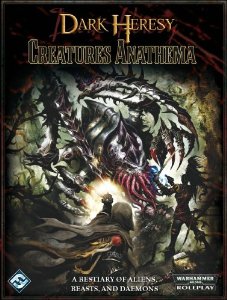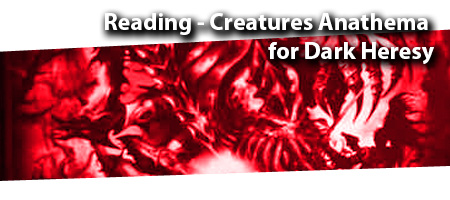Reading – Creatures Anathema for Dark Heresy
NOTE: This was written over five years ago and is posted here as part of my “collect my work from the web” project . . . that’s very slow going.
Despite the fact that I’ve stated my intention to review every release in the Warhammer Fantasy Roleplay* series, I again find myself deep in another release in the Dark Heresy* series. The guys over at Fantasy Flight Games were kind enough to ship me a copy of the latest book in the series, Creatures Anathema*, and I just can’t resist the desire to review a new book of monsters. I’m sure I’ll get back to the Warhammer Fantasy Roleplay* reviews but, for now, I’ve gotta share my thoughts on Fantasy Flight’s latest release for the Warhammer 40k roleplaying game, Dark Heresy*.

Overview
A 144-page hardcover, packed with color artwork and the same, high-quality graphic design as the other books in the series, Creatures Anathema* is the “Old World Bestiaryâ€* (which I’ve already reviewed) of the Dark Heresy* line; which is to say that this is a book of monsters that’s well-written and loaded with great ideas. The book’s smooth, matte finish cover fits in perfectly with the other Fantasy Flight releases in the series (the hardcover reprints and Disciples of the Dark Gods*), and the artwork, again by Clint Langley, is attractive, featuring a party against a Lictor (keep reading). At a glance, this is an excellent addition to the line and every bit as professionally presented as the other books in the series.
A Closer Look
Creatures Anathema* is broken into seven chapters, six of which are devoted to different types of monsters and other adversaries (the book is subtitled “A Bestiary of Aliens, Beasts, and Daemons,†and it lives up to that name); the seventh chapter, titled “Adversaries,†isn’t an adventure like I expected but is actually a reference piece for GMs that – as it says in the book’s introduction – includes:
“. . . advice on how to scale enemies for your player group and some optional rules to shape the roles of enemies in the game.â€
Chapter-by-chapter, Creatures Anathema* breaks down as follows:
- Chapter One – Mutation: Eight pages long, this first chapter of the book describes three different potential opponents for the players to fight. The chapter also fully sets the stage for the basic style throughout the rest of the book: each chapter opens with a short introduction to the types of creatures that will be found, a box on using the material in your game, and then a detailed two- or three-page description of each creature (including game statistics, scraps of flavor text, and adventure seeds). Though short, this is a strong start to the book.
- Chapter Two – Forbidden Science: An unfortunate typo on the chapter’s splash page (“tech-eresyâ€) sets us off on the wrong foot but, I’m happy to report, the chapter quickly recovers and dives immediately into eight monsters that are tied directly to inhuman Xenos Tech. 24-pages long, this chapter includes:
Lysee the Murderess, a “Tech-Witch†on the world of Sinophia – a corrupt world that would no doubt make an excellent site for an adventure in which the players must track down (and destroy) an evil member of the world’s machine cult. Though she is named, Lysee is presented as a generic witch and her stats can be easily used with any witch of the GM’s design.
Vore-Weapons, which are described as “a living assassin’s tool crafted by heretek generator and xenobiologis tech,†an unusual living weapon that could have been presented as bizarre equipment, if the authors had wanted to. The choice to present is as a creature, though, just drives home what an unusual “item†the vore-weapons are. The statistics are imaginative, with special abilities like “Find the Flesh,†“Burrow into the Flesh,†and “Get it Off Me†showing just how twisted and weird these weapons are.
- Chapter Three – Death Worlds: With this 12-page chapter the book makes a slight change in format, with the chapter detailing three different death worlds – defined as “planets which are too dangerous to support widespread human settlement†– and describing (in detail) one creature native to each world. Additionally, one of the worlds (Kenov III) includes brief text descriptions of four other creatures that the GM could use as a basis for new designs (using the rules found in the GM Screen*).
While the art is beautiful (I especially love the full-page Ripper Whip art on p. 41), and the text is fun, the decision to include so much flavor text in the chapter cut down on the number of monsters. By dropping two full-pages of supplementary flavor text the authors could have included one more death world, which would have made this chapter more useful to GMs. This may very well be the weakest chapter in the book.
- Chapter Four – Vermin & Predators: 26-pages long, with ten warped, wacky creatures, this chapter immediately makes up for the previous chapter. The monsters described in this chapter range from humanoid-like creatures with psychic powers (including game statistics for two new psychic powers) to four-legged beasts to an insectoid monstrosity. Some specifics for those of you who want details:
Star Wars fans (raises hand) will no doubt love the Fenksworld Pit Thing, a hive creature that looks a lot like the Rancor from Jabba’s palace, except that it’s smaller and its head is a wide-open maw of sharp teeth.
Sinophian Boreworms (from the same world as the previously-mentioned tech-witches), a very small monster that burrows into a body and then starts to break apart into smaller worms, each of which continues eating at the body. A truly disgusting creature. I love it.
Xothix Blood Locust, rated as Xenos Majoris, are a swarm creature that (as you’ve probably guessed from the name) drinks the blood of its victims. The flavor text, one of the boxed entries from Inquisitor Felroth Gelt, truly gets across the terrible nature of these creatures: “A vast, black cloud of Blood Locusts rose out of the dead grass and swarmed over us. Two of our number were overcome almost instantly. I can only pray their deaths were quick.â€
- Chapter Five – Xenos: This chapter gives Warhammer 40k fans exactly what they’ve been writing house rules for since Dark Heresy* was first published last year. With statistics and equipment for Eldar, Enoulians, Enslavers, Genestealers, Lictors, Orks, and Simulacra, a Dark Heresy* GM should have no problem dumping tons of pain on the players. The included stats cover not only generic members of the different alien races described but also a few specific personalities and some creatures, making this 32-page chapter easily the best one in the book.
My favorite creature in this chapter? Definitely the Lictor, a Xenos Terminus-rated monstrosity that should terrify any group of player characters. The book reports that no known Lictors are operating in the Calixis Sector, but I’m pretty sure it’s only a matter of days after this book hits shelves before the Calixis Sector is overrun by these monsters in hundreds of Dark Heresy* game sessions. After all, a beast this cool shouldn’t stay locked away inside the book. Check out this Wikipedia entry to learn about Lictors.
In terms of monster love, for me the genestealers come in a close second, just behind the Lictor, but only because of the Space Hulk game. Between these statistics and the adventure in the Dark Heresy scenario book, Purge the Unclean*, GMs have basically everything they need to toss the players into a Space Hulk-inspired campaign. Travel from hulk to hulk, killing in the name of your Inquisitor master!
- Chapter Six – Forces of Chaos: Focusing on daemons, warpspawn, and creatures of chaos, this 24-page chapter is the last section of the book with monster descriptions/statistics and it certainly doesn’t disappoint. With some of the best adventure seeds in the book, and gruesome imagery, the eleven opponents described in this chapter cannot help but inspire the GM, even if some of that inspiration may lead to unsettling dreams in the darker hours of the night. I’m not sure who was responsible for choosing the creatures for this chapter but he deserves a big “thank you,†because each one of these – from the astral spectre to the ruination of imperfect beauty – are creepy and imaginative. I have no doubt that players out there will soon be cursing the Lady of the Voids as her terrible song drives their characters deeper into madness.
- Chapter Seven – Adversaries: A 12-page GM advice chapter (as I already mentioned, above), the way in which the material is presented makes it easy to digest and is a format I’d like to see more GM advice pieces follow. The chapter provides tips for using human enemies, aliens, and unnatural beasts in games, dividing each into three steps so that GMs are given advice on handling everything from the lowest-level human hirelings to the most powerful daemons.
For example, the section on humans – The Evil You Know: Hereticus – tells GMs to start with minions and thugs, then escalate to lieutenants, and finally, to wrap things up with the main villains. Yes, it’s pretty common advice, but the way in which it’s presented is nice and by clearly breaking each section out under a different head it’s easy to follow (and even easier to spot when you flip back through the book at a later time).
In addition to advice, the chapter also includes optional rules for minions (two different options, titled “Simple Minion Rules†and “Colorful Minion Rulesâ€), advice on cinematic-styling, and a discussion on making a player character death meaningful and memorable (the idea being that players will be happier if their characters’ deaths aren’t just a split-second even but actually get some “screen time†during the session).
It’s a short chapter, but it’s worth reading through at least once and at less than 10% of the book’s total page count its space well used.
Last Thoughts
Though I entered into Creatures Anathema* with high hopes, I secretly feared that a lot of the artwork (and creature descriptions) would be regurgitated material lifted directly from the Black Library’s excellent Xenology* book (which I’m very happy to have picked up before people started demanding ridiculous prices for it). I should have given Fantasy Flight and the authors the benefit of the doubt because, after going through Creatures Anathema*, it appears to me that my secret fear was completely unnecessary. This latest book for the Dark Heresy* series is easily the best in the series and a must-buy for any Dark Heresy* GM.
If you’re on a limited budget (which isn’t at all unusual these days), and can only purchase one supplement for the Dark Heresy* line, I’m going to have to say that Creatures Anathema* has crawled its way to the top, shoving aside all of the books that have come before. Though it doesn’t include the “Creating Your Own Creatures†rules from the GM Screen* (which I reviewed here), there are enough beasts in this book – and adventure ideas for each – that the book should keep a campaign running for many months.
Fantasy Flight, and especially developer Ross Watson, deserves a huge thanks from Dark Heresy* fans. Not only did the company step in and save the roleplaying game from extinction they’re proving – with both this release and Disciples of the Dark Gods* – that they fully intend to produce only the best materials possible.
I’m looking forward to their next release in the series.
